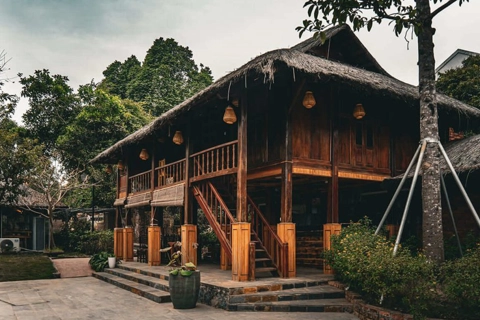Travel
Son Tay Ancient Citadel tells of its past while inspiring the future
Mar 18, 2015 / 01:22 PM
Under the mossy old gate of the Son Tay Ancient Citadel, embraced by huge roots of 100-year-old trees, a group of teenagers were chatting and laughing and trying to take photos of each other. Not far from them, two young boys were fishing by the tranquil moat around the citadel. Their joyful laughter broke the calm surrounding the site.

Visitors' first image of Son Tay Ancient Citadel is a group of ancient trees, hundreds of years old.
|
The citadel seems to be forgotten among other more touristy sites in the centre of Ha Noi, but I strongly encourage a visit there if one wants to explore its unique architecture, find calm after a busy work week in the noisy city or just discover traces of the past.
Built in the third year of King Minh Mang (1822), this 16ha site is home to the only Vietnamese citadel built with da ong (laterite) bricks. From its walls to stairs in different buildings and wells, all are built with the typical building material of Son Tay. The four gates – West, East, South and North – are made of the same material.
The ancient compound has been rated one of the most famous and beautiful citadels in northern Viet Nam. Not many built under the reign of King Minh Mang still exist today.
According to its historical bibliography, the citadel was built to be very sturdy, to protect the northwestern area of Thang Long (now Ha Noi).
From 1870 to 1880, the Nguyen dynasty used the citadel to resist French invaders, but it fell into their hands in 1883.
After the French army occupied the citadel, in 1924, Martial Henri Merlin, governor-general of French Indochina, issued a decree making the ancient citadel a relic.
Because of its cultural and historical value, in 1994 the Ministry of Culture and Information (now the Ministry of Culture, Sports and Tourism) recognised the Son Tay Ancient Citadel as a National Architectural Historical Relic.
In 2009, some relics in the ancient citadel were upgraded and restored to celebrate the 1,000th anniversary of Thang Long – Ha Noi.
Original architecture
The citadel is located in two of the town's ancient villages: Thuan Nghe and Mai Trai.
Built in the style of France's Vauban architecture, the square citadel is 400m in length and 5m in height. Its wall was 4m wide, with holes at the top for soldiers to hide inside and attack their enemies using spears or broadswords.

Ascension: The ramparts, as well as the stairs leading to citadel buildings, are all built using da ong, a typical construction material used in Son Tay.
|
In his memoirs written in April 1884, Charles Edouard Hocquard, a French military doctor, described the Son Tay Citadel's architecture in detail: "…In the middle of the citadel was an 18m high flagpole. The remaining part was the royal corridors, residential buildings of the provinces' mandarins and a food store. In front of the flagpole were two large square cisterns with their surroundings built with bricks with handrails. Many people said that one of the cisterns had been used to contain water for soldiers and the other for raising fish to serve as a food."
Some other important structures inside the citadel include Vong Cung Nu, where the kings could rest and mandarins in the area annually organised offering rites or bowed from a distance when they received royal decrees.
To the west of the citadel is Vo Mieu, which was built to worship those who laid down their lives to protect the fort. Four square wells, each 6m in depth, were built at the four corners of the citadel. Steps lead down to the bottom of the wells.
After nearly 200 years, most of the Son Tay Citadel has been destroyed by wars and time. Only a few relics are left, including the flagpole, some stretches of the citadel walls, the citadel gates, guard towers, Kinh Thien's Palace platform, wells and two cannons.
The ancient citadel would impress anyone visiting it today, with its serenity and calm.
Ancient trees give it shade all year round. Orchids, lotus ponds, and green grass have created a picturesque site.
The peaceful scenery of the citadel has made it an ideal location for wedding photos.
"I had visited this site several times and was impressed by its beauty," said groom-to-be Tran Thanh Nam, from Bac Ninh province.
"I decided to preserve these precious moments of our life today with the beautiful and serene landscapes of this site as the backdrop."
As for me, I will surely never forget the image of hundred-year-old trees stretching their roots to cover the mossy citadel walls and gates.
The rough roots stretch out, embracing the moss walls and the ruined gates. It creates an ancient beauty. It felt like time stopped during the few moments I stood there, watching.








